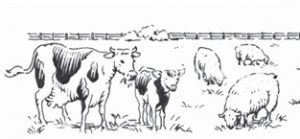24 hour emergency service
017683 51819
Office opening hours
Monday-Friday 8am - 6pm
Saturday 9am - 1pm
Sunday 10am - 11am
Crosscroft Industrial Estate Appleby-in-Westmorland CA16 6HX

NEWSLETTER
October 2018 Edition
As we say goodbye to summer, it's time to focus on the next challenge, whether that be tupping, autumn calving or j ust preparing for winter.
ust preparing for winter.
'We would like to wish Sophie and Richard massive congratulations on their recent engagement, it really is lovely news and we are all very excited in the office at the prospect of a good party!!!! We wish them all the very best for a long and happy future together.
We would also like to congratulate Kay, our newest recruit, on the safe arrival of her 9 collie puppies.'
Focus on Mastitis
Making the most of your cell count data
Milk recording forms a crucial part of monitoring the health of your cows and can provide a huge amount of useful information when trying to pin point where a problem is coming from. The more regularly you record, the more data there is to work with, however, even less regular testing can aid in diagnosing problems.
So, you have a high cell count cow, what next? Things you should consider when looking at her data
Is this her first high cell count? Or has she had high cell counts before, either in this lactation or previous, multiple high cell counts can indicate a chronic infection. If she recorded high before drying off and is still high at first recording, this indicates she hasn’t cured over the dry period.
Where is she in her lactation? If this is her first recording after calving, it’s likely she picked up the infection during the dry period or at calving time. If she spikes high later during lactation its likely she’s picked up infection from the parlour or the shed/pasture.
Does she have clinical mastitis? Or is the high cell count the only sign, this can help identify which bug might be causing the problem. For example, E.coli mastitis will likely cause visible changes in the milk and a sick cow, but infection with Staph. Aureus can be subclinical ie, only elevated cell counts.
Is she the only high cell count cow from the group, or are there multiple cows spiking high at the same time? This could relate to a seasonal or management change, it is worth looking back over previous years data to see if the trend is repeated year on year.
What is your herds Johne’s status? Johne’s can contribute to high cell counts and reduced fertility in the herd.
Having considered the above, we can start to target our approach to eliminate the cause of high cell counts in the herd.
Triclabendazole resistance
How to stop it developing on your farm
Liver fluke, or Fasciola hepatica, is considered to be endemic in the wetter areas of the UK. This of course includes the Eden valley and surroundings where we are not unfamiliar with a spot of rain! For years the mainstay of treatment has been products containing Triclabendazole, as these are effective against all stages of fluke. Unfortunately our reliance on Triclabendazole has lead to resistance developing on farms across the country.
Triclabendazole is a drug we still want as part of our armoury when dealing with fluke, but to preserve its usefulness we must use it sparingly and with other measures on farm. Here are some suggestions for tackling fluke;
- Grazing management, fence off wetter areas of pasture and consider not grazing high risk pastures during periods of highest risk (late summer/autumn).
- Only use flukicides when necessary, take into account the history of occurrence on your farm, parasite forecasting (NADIS provides monthly updates on parasite forecasts) and if we have diagnosed fluke on your farm (through muck sample analysis).
- Only use Triclabendazole when targeting immature flukes, at times of the year when acute fluke disease is likely (such as late summer/early autumn) it is appropriate to use triclabendazole. At other times, when targeting mature flukes is the goal (winter, spring and early summer), consider using a different treatment (we stock Albex, Solantel and Closamectin).
- Correct dosing, weighing individual animals for dosing is best practice, however we know that this is not always possible, so animals should be grouped together according to estimated weight and dosed for the heaviest animal in the group. Underdosing animals can lead to some fluke surviving.
- Quarantine incoming stock, reducing the risk of introducing resistant fluke to your farm, SCOPS and COWS provide good guidelines for quarantining sheep and cows respectively.
- Carry out resistance testing via faecal egg reduction tests so we can assess the current situation on your farm. Please call the surgery to discuss or for the protocol for testing.

Top tips for Tups Preventing blocked rams
Stones, or uroliths, can form in the bladder of tups fed on concentrate rations that are high in phosphate and magnesium. These stones can then lodge in the urethra (the tube that carries urine from the bladder to the outside), and cause a full or partial blockage. A blocked urethra not only causes severe discomfort, but can lead to kidney failure and death if left untreated.
What to look for:
Teeth grinding and signs of pain Lack of appetite
Separation from the group Swollen prepuce
Bloody urine dripping from the prepuce
Presence of crystals in the wool around the prepuce may be indicative of stones, but can also be present in normal tups.
If you notice a tup displaying any/all of the above signs, please contact us for advice as prompt veterinary treatment is essential in cases of blocked rams.
This problem can be avoided by providing a source of fresh accessible water, adding ammonium chloride to the ration, supplementing the diet with sodium chloride (to increase water intake) and providing adequate roughage to stimulate saliva production and increase water uptake.
‘WORM YOUR HORSE’ due to the weather conditions this summer we are seeing a huge and sudden burden of worms in our equine population. This is causing serious clinical signs including colic which is leading to death in some cases. Please prevent the risk by fetching us muck samples so we can check for worm burden before it causes any problems and advise on a worming plan.'
